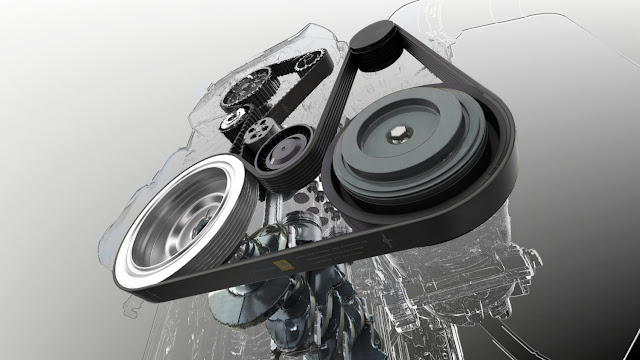BAY CITY, Mich.,---We at Hank Graff Bay City would like to remind you why you should have your belts and hoses inspected for National Care Care Month. When it comes to keeping your vehicle running smoothly, your belts and hoses are crucial parts of your engine because they're the whole reason it's able to run! Normal use will cause them to wear down over time, but both are more susceptible to damage in extreme hot or cold weather. Hot weather can add heat on top of existing friction, which causes them to wear down a lot faster, while cold weather can make them stiff and prone to cracking.
By following scheduled maintenance and going in for regular inspections, you can be sure that your belts and hoses are working properly. While they don't often require replacements, inspections can catch minor issues before they become major problems. Here we have some tips below on the various kinds of belts and hoses that help your car run, as well as how to spot any signs of damage.
BELTS
Your engine's belts control things like your AC compressor, water pump, alternator, engine valve intake and exhaust, and power steering. A broken belt can completely disable your vehicle, and the changing temperatures that come with springtime can make them more prone to wear. Damaged, cracked, or frayed belts can still run but can cause even bigger issues like your engine overheating. While they don't often require replacements, it is important to get your belts inspected regularly.
There are two kinds of belts your engine uses: the timing belt and the accessory or serpentine belt.
Timing Belt: Also known as the Cam belt, the timing belt synchronizes the rotation of the camshaft and crankshaft. This helps the engine's valves open and close at the right times during the cylinders' intake and exhaust strokes. You should have your timing belt replaced every 60,000-100,000 miles or whenever your owner's manual tells you to do so, and here are a few signs to look out for that may indicate a replacement is in order:
- Your engine "jumps" gears
- Your vehicle is completely disabled
- There are plastic pieces from the camshaft gears in your oil pan
- There is loss of oil pressure (due to the camshaft pieces being in your oil)
- You hear a squeaking noise from your timing cover
- You hear rattling noises coming from your engine
- You have trouble starting your vehicle
Accessory or Serpentine Belt: Most vehicles usually have one or two drive/accessory belts. Also known as the "serpentine" belt, the accessory belt gets its name from the snake-like motion it uses around the pulleys of the engine. Its job is to transport power to components like your power steering pump, AC compressor, alternator, and many others.
Water, dirt, oil leaks, and excessive heat can cause your serpentine belt to wear down very quickly. You should have it inspected every 10,000-20,000 miles, and replaced every 60,000-100,000 miles or whenever your owner's manual tells you to do so. Here are a few signs that your accessory belt might need replacing:
- An overheating engine
- A disabled vehicle
- A loss of power steering
- A squealing or high-pitched noise while accelerating
HOSES
In the same way your circulatory system moves blood and oxygen around your body, your engine's hoses move fluids vital to your car's performance throughout its entire system. A cracked or damaged hose can lead to the leaking of these vital fluids, like coolant or brake fluid, and reduce the efficiency of your vehicle. There are several kinds of hoses inside your car:
Radiator Hoses: This hose moves coolant through your engine to regulate its temperature. Without it, your engine can overheat which can in turn case major internal damage and lead to costly repairs. Here a few indicators of a radiator hose leak:
- Drop in coolant level
- Smoke coming from your engine
- Rising engine temperature
- A bright pool of liquid underneath your vehicle
Fuel Line: The fuel line transports fuel from your fuel tank to the fuel pump, and are typically made out of reinforced rubber but can also be made out of plastic or metal. While they aren't usually a part of your vehicle's routine maintenance, it is extremely important to have them checked before the end of the fall or beginning of spring when temperatures are changing drastically. Here are some signs you may need to replace your fuel line:
- Loss in fuel efficiency/gas tank emptying faster than normal
- Puddles of gas underneath your vehicle
- Smelling gasoline while driving
- Hard starts
- Your vehicle not starting at all
Brake Lines/Hoses: Brake lines and hoses are used to stop your vehicle when you depress the brake pedal. Some vehicles made of steel and some made of rubber, but rubber takes the majority for the flexibility it provides to your car's suspension when traveling on uneven surfaces. Here's how to tell if you have a broken brake line or hose:
- Loss of braking ability
- "Soft" brakes
Now that you know why you should have your belts and hoses inspected for National Car Care Month, schedule an appointment with our friendly and knowledgable service team today, and we'll help you keep your vehicle running at its best this spring and get it ready for your summer adventures!
Hank Graff Chevy is located at 3636 Wilder Road, Bay City, MI 48706 and we are here to help our community grow to become an even better place to call home! For more information on Hank Graff Chevrolet, or for any questions call us at (989) 684-4411 or visit our website: www.GraffBayCity.com.




No comments:
Post a Comment